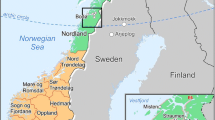Abstract
Traditional subsistence pastoralists are often seen as causing environmental degradation through overgrazing, and are also seen as responsible for a decline in wildlife numbers through resource competition and habitat change. This paper investigates recent ideas on the interaction of pastoralism and conservation that question the validity of the concepts of overstocking and overgrazing as applied to arid and semiarid rangelands. The Ngorongoro Conservation Area, a Maasai pastoralist/wildlife conservation joint land use area in northern Tanzania, shows no clear signs of pastoralist-induced environmental degradation despite a preoccupation with this possibility by successive administrations. Ecological studies together with other considerations suggest that joint land use works to the long-term benefit of both pastoralism and conservation in this and other areas.
Similar content being viewed by others
References
Arhem, K. (1981). Maasai pastoralism in the Ngorongoro Conservation Area: Sociological and ecological issues. BRALUP Research Paper No. 69, University of Dar es Salaam, Tanzania.
Campbell, B. (1983).Human Ecology (Chap. 8).Pastoralism. Heinemann, London.
Campbell, D. (1984). Response to drought among farmers and herders in Southern Kajiado District, Kenya.Human Ecology 12: 35–64.
Conant, F. (1982). Thorns paired, sharply recurved: Cultural controls and rangeland quality in East Africa. In Spooner, B., and Mann, H. (eds.),Desertification and Development; Dryland Ecology in Social Perspective. Academic Press, London.
Ecosystems Ltd. (1980). (i). Livestock, wildlife and land use survey of Arusha Region, Tanzania; (ii). The status and utilisation of wildlife in Arusha Region, Tanzania, USAID Contract no. AID/AFR-C-1556, Ecosystems Ltd., P.O. 30239, Nairobi, Kenya.
Hardin, G. (1968). The tragedy of the Commons.Science 162: 1243–1248.
Hiort, A. (1982). A critique of “ecological” models of pastoral land use.Nomadic Peoples 10: 11–27.
Homewood K., and Rodgers, W. (1984). Pastoralist ecology in Ngorongoro Conservation Area, Tanzania. ODI Pastoral Network Paper 17d, London.
Institute for Resource Assessment. (1983).A Revised Management Plan for the Ngorongoro Conservation Area. University of Dar es Salaam, Tanzania.
Jewell, P. (1980). Ecology and management of game animals and domestic livestock in African savannahs. In Harris, D. (ed.),Human Ecology in Savannah Environments. Academic Press, London, pp. 353–382.
Kjekshus, H. (1977).Ecology, Control and Economic Development in East African History: The Case of Tanzania 1850–1950. Heinemann, London.
Little, P. (1984). Critical socio-economic variables in African pastoral livestock development. In Simpson, J., and Evangelou, P. (eds.),Livestock Development in Subsaharan Africa. Westview Press, Boulder, Colorado, pp. 201–214.
Nyerges, A. (1982). Pastoralists, flocks and vegetation: Processes of coadaptation. In Spooner, B., and Mann, H. (eds.),Desertification and Development: Dryland Ecology in Social Perspective. Academic Press, London.
Pennycuick, C. (1979). Energy costs of locomotion and the concept of a foraging radius. In Sinclair, A., and Norton-Griffiths, M. (eds.),Serengeti: Dynamics of an Ecosystem. University of Chicago Press, Chicago, pp. 164–182.
Sandford, S. (1982). Pastoral strategies and desertification: Opportunism and conservatism in dry lands. In Spooner, B., and Mann, H. (eds.),Desertification and Development: Dryland Ecology in Social Perspective. Academic Press, London.
Sandford, S. (1984).Management of Pastoral Development in the Third World. ODI, London; John Wiley and Sons, Chichester and New York.
Sinclair, A., and Norton-Griffiths, M. (1979).Serengeti: Dynamics of an Ecosystem. University of Chicago Press, Chicago.
Swift, J. (1982). The future of African hunter gatherer and pastoralist peoples.Development and Change 13: 159–181.
Swift, J. (1983). The start of the rains. Research memo, Institute for Development Studies, Sussex University.
Western, D. (1975). Water availability and its influence on the structure and dynamics of a savannah large mammal community.East African Wildlife Journal 13: 265–286.
Western, D. (1982). Amboseli National Park: Enlisting landowners to conserve migratory wildlife.Ambio 11(5): 302–308.
Author information
Authors and Affiliations
Rights and permissions
About this article
Cite this article
Homewood, K.M., Rodgers, W.A. Pastoralism and conservation. Hum Ecol 12, 431–441 (1984). https://doi.org/10.1007/BF01531127
Issue Date:
DOI: https://doi.org/10.1007/BF01531127




